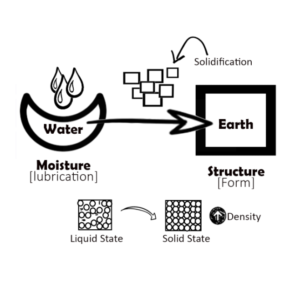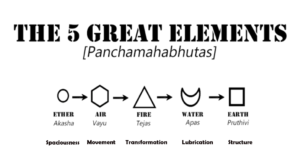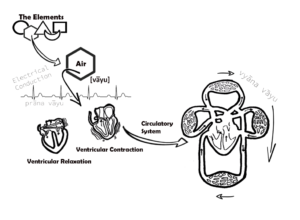Disclaimer:
All content included on this website (including, but not limited to, images, photos, graphics and text) is the property of ‘Healthy Ayurveda’ and ‘Vedic Sage’ and as such is protected by US and international copyright and other intellectual property laws.
Panchamahabhutas ~ The 5 Great Elements
“The Individual Is The Epitome Of The Universe”

Charaka, the ancient seer of Ayurveda, states that “the individual is the epitome of the universe”. This implies that – that which exist in the vast eternal universe also appears within the inward cosmos of the human body.
Caraka Samhita Sarirasthana Ch. 5 Verse 4
The individual is the epitome of the universe as all the material
and spiritual phenomenaof the universe are present in the individual
and all those present in the individual are also contained in the universe.”
The Elements In A Nutshell …

Humans are the perfect example of the universe because we are the microcosm of the universe and made of the very elements for which the entire universe is made from and these elements are referred to as “Panchamahabhutas” … translated as ‘The 5 Great Elements’.
e·pit·o·me (noun)
A person or thing that is a perfect example of a particular quality or type.
Elements In Nature …
These “5 Great Elements” exist in all matter and are the building blocks of the known universe.
The “5 Great Elements” [ether, air, fire, water, and earth] manifest not only in the physical body but exist in all of nature and are the building blocks of the known universe.
Intially, we can attribute a basic theme to the elements.
For example:
– ether provides spaciousness which ‘allows’ for movement
– air provides the driving force behind all movement
– fire represents and symbolizes transformation and illumination
– water is lubricating, provides mositure and is cooling
– earth provides structure, form and stability
THE 5 GREAT ELEMENTS …
ETHER/SPACE
Aakasha
Nothing; No-Thing
 Long ago, before there was anything, there was “nothing”; i.e. no-thing, just space. Generally, when we measure “something” there is a point of reference [i.e. “here”] from where measurement begins to another point of reference [i.e. “there”]. However, in absolute space [i.e. ether] where there is “no-thing”, there is neither ‘here’ nor ‘there’ from which to measure and therefore a state which is immeasurable. Being immeasurable, space [i.e. ether] is all-pervasive, vast, dimensionless and essentially, … indescribable.
Long ago, before there was anything, there was “nothing”; i.e. no-thing, just space. Generally, when we measure “something” there is a point of reference [i.e. “here”] from where measurement begins to another point of reference [i.e. “there”]. However, in absolute space [i.e. ether] where there is “no-thing”, there is neither ‘here’ nor ‘there’ from which to measure and therefore a state which is immeasurable. Being immeasurable, space [i.e. ether] is all-pervasive, vast, dimensionless and essentially, … indescribable.
Describing The Indescribale …
Despite being intangible, the ancients provided us with various qualities as an attempt to further understand that which is indescribable; i.e. ether/space.
Qualities of Ether/Space:
– minute
– light
– soft
– smooth
[Caraka Samhita Sutrasthana Ch. 26 sutra #11]
Practically Speaking …
 Space/Ether is vast, expansive, and all-compassing. However, it is challenging to comprehend such descriptions of space. Therefore, from a practical perspective, we can look upon the element of space as being predominately contained within various bodily cavities. After all, the body is vastly space.
Space/Ether is vast, expansive, and all-compassing. However, it is challenging to comprehend such descriptions of space. Therefore, from a practical perspective, we can look upon the element of space as being predominately contained within various bodily cavities. After all, the body is vastly space.
For example:
cranial cavity [ventricular space]
sinuses within the skull
vertebral cavity
thoracic cavity
abdomino-pelvic cavity
The Importance of Space/Ether:
Space Allows For Movement
Space/Ether allows for the potential to move
Whereas: Air/Vayu provides for the ability to move. [discussed further below pg.]

The space within the brain [ventricular space] allows for the passage and movement of cebrospinal fluid [CSF], the space within the thoracic cavity allows for the movement of air via the respiratory tract and the movement of blood [i.e. cardiovascular circulation] via the space within the chambers of the heart and the intravascular space within the lumens of various blood vessels. Similarly, the abdomino-pelvice cavity allows for the movement of various substances via the space in the lumen of gastrointestinal tract, genitourinary tract etc.
Ultimately, space exists everywhere …

Between cells [i.e. intracellular space], within cells [i.e. intracellular space], and even between atoms!!
Space Out On This!!

Atoms are 99.999999999999% empty space. The space between the nucleus of two atoms is around 10-10 meters. That’s basically one ten-billionth of a meter. That’s alot of space!!
AIR/VĀYU
As described previously, space/ether allows for the potential to move. Meaning, if there is no space to move … movement ceases. Air/vayu, on the otherhand, is the driving force behind all movement. Simply said, vayu or air is the principle of movement.
The Evolution Of Space Into Air
As described earlier, with absolute space [i.e. ether] there appears to be a dimensionless realm which is vast and all-pervasive. Being all-pervasive, there is no point of reference as being ‘here’ and ‘there’ and therefore the inability to measure distance; i.e. NO movement.
Being Philosophical …
Seemingly, from nothing, came something. However, from a philosophical perspective there exist a state of being [i.e. Purusha] from which the primordial sound [Aum] arouse which initated movement via vibration from which the entire universe came to be.
Qualities of Air/Vayu:
– Light
– Cold
– Rough
– Coarse
– Non-slimy
Vayu Represents All Movement
Life is movement and movement is a fundamental function shared by all living organisms. In fact, definitive characteristics of life include organization, metabolism, responsiveness, movement, development, and reproduction. The root word ‘va’ means “to spread” [i.e. movement] and vata dosha which is predominately comprised of ether and air elements provides the driving force for all movement within the body.
- movement
- roughness
- reduction
- lightness
- non-sliminess
Caraka Samhita Sutrasthana Ch. 26 sūtra 11
– Central Nervous System: neurotrasmission, sensory & motor innervation; action potentials
– Cardiovascular System: circuation, movement of plasma, blood, lymph, and nutrients
– Respiratory System: ventilation and movement of gases via inspiration and expiration
– Gastrointestinal System: movement of nutrients via digestion/absorption/assimilation; movement of excreta; feces.
– Genitourinary System: movement and ultrafiltration of plasma into urine
FIRE/TEJAS
With the evolution of ether into air, came space and movement. The movement of vāyu brought forth vibration. The back-and-forth vibrational movement of vāyu introduces friction and with friction comes heat; i.e. fire.
The Principle Of Transformation:
Fire is radiant energy and is active and changeable. It is the source of all transformative processes in the body and is responsible for digestion, absorption and transformation of food into energy.
Qualities Of Tejas/Fire:
– Hot
– Sharp
– Minute
– Light
– Rough
– Non-slimy
The qualities of hot, dry, penetrating and sharp demonstrate the radiant energy of Fire in the body. Skin complexion, eye luster and intelligence are expressions of the elemental energy of Fire. The liver, stomach and the pancreas are the primary sites of the Fire element. The element of Fire brings the qualities of attention, appreciation, recognition, ambition and competitiveness.
Functions Of Fire:
- Heat
- Digestion
- Luster
- Light
- Complexion
Ignite; to catch fire.
Agni; fire
Relationship Between:
– Fire
– Agni [hot, sharp, light, dry, subtle]
– Pitta [fire & water], hot, liquid, oily, sharp, penetrating
Agni: The Digestive Fire
Agni is the expression of fire and it is that which governs all transformation.
One Flame, Many Embers:
The fire element of Agni works on many levels [i.e. a fire that has many flames] but from a systemic perspective we can look upon the main flame of Agni as Jathara Agni; i.e. the digestive flame which encompasses but is not limited to the stomach [āmāshaya] and the small intestine [grahani].
Pitta Dosha
Pitta is a Sanskrit word means illumination often associated with the brilliance, which radiates from fire. The elements fire and water combine to form Pitta dosha. It is the principle of transformation energy. It governs heat, digestion, and metabolism.
llumination: Fire In The Mind [Sadhaka Pitta]
Often, when describing intelligence of another, we use such words such as bright, brilliant, and sharp … which are all qualities of the fire element and pitta dosha. Pitta dosha is predominately made of fire and water elements. Sadhaka pitta is located in both the brain and heart and is responsible for intelligence, comprehension and understanding.
WATER/AP

The cool aspect of water is the natural balance to the heating energy of fire. Water provides the chemical energy that brings molecules cohesively together. Condensation is any reaction which two molecules combine with the formation and loss of water. With regards to the evolution of elements, after the formation of fire via friction water was formed by condensation.
Qualities Of Water:
– Light
– Unctuous
– Cold
– Dull
– Soft
– Slimy
The energy of water can be seen in all fluids, from cerebral spinal fluid to digestive juices. Blood, sweat, plasma, saliva and urine are the primary sites of the element of Water.
Functions Of Water:
– Moistening
– [lubricating]
– Binding
– Oozing
– Softening
– Exhilirating
- CSF
- Saliva
- Plasma/Pericardial fluid
- Pleural fluid
- Gastric juices
- ultrafiltrate of plasma/urine
- Intracellular fluid/cytoplasm
EARTH/PRITHVI

Earth element occurs via solidification and manifests as mechanical and physical energy. It can be seen as the structure and solid support of all matter, organic and inorganic.
Solidification:
A phase change of matter that results in the production of a solid structure.
Qualities Of Earth:
– Heavy
– Coarse
– Hard
– Dull
– Stable
– Non-slimy
– Solid
– Gross
Within the body, the qualities it imbibes of hard, heavy, rough and dense are seen through the manifestation of the bones, nails, teeth, hair and skin. All the solid structures in the body are seen through the essence of the earth element. The primary sites of this physical energy are the bones, hair, teeth, cartilage and tendons. The qualities of forgiveness, support, growth and attachment are fostered by the Earth element.
Functions Of Earth:
– Development
– Compactness
– Heaviness
– Firmness
DISCLAIMER:
All content included on this website (including, but not limited to, images, photos, graphics and text) is the property of ‘Healthy Ayurveda’ and ‘Vedic Sage’ and as such is protected by US and international copyright and other intellectual property laws.




















![Female Health: Amenorrhea [cessation of menses] – An Ayurvedic Perspective](https://healthyayurveda.com/wp-content/uploads/2015/07/1.-Amenorhea--327x219.png)




